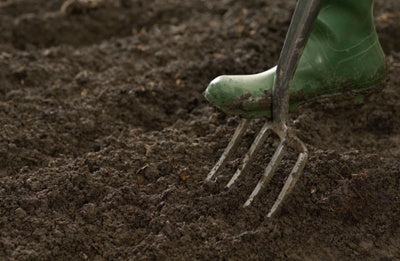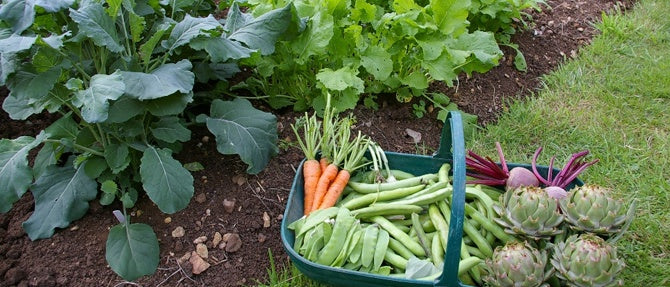Grow a Kitchen Garden
In its simplest form, a kitchen garden produces fresh fruits, vegetables and herbs for delicious and healthy meals. A kitchen garden doesn’t have to be right outside the kitchen door, but the closer it is, the better. Think about it this way: the easier it is for you to get into the garden, the more likely it is that you will get tasty things out of it. Did you forget to add the chopped dill on your boiled red-skinned potatoes? No problem — it’s just steps away.
Plus, growing vegetables can be fun. It’s a great way to spend time with children or have a place to get away and spend time outdoors in the sun.
Follow our easy steps below and before you know it, you will be harvesting your dinner from right outside your door.
Planning

If you have to choose between a sunny spot or a close one, pick the sunny one. The best location for a new garden is one receiving full sun (at least six hours of direct sunlight per day), and one where the soil drains well. If no puddles remain a few hours after a good rain, you know your site drains well.
After you’ve figured out where the sun shines longest and strongest, your next task will be to define your kitchen garden goals. Our first recommendation for new gardeners is to start small, tuck a few successes under your belt in year one, and scale up little by little.
Preparing

If you’re starting your kitchen garden on a patch of lawn, you can build up from the ground with raised beds, or plant directly in the ground. Building raised beds is a good idea if your soil is poor or doesn’t drain well, and you like the look of containers made from wood, stone or corrugated metal. This approach is usually more expensive, however, and requires more initial work than planting in the ground.
Whether you’re going with raised beds or planting directly in the ground, you’ll need to decide what to do with the ground surface. You can remove it and compost it, which is hard work, but ensures that you won’t have grass and weeds coming up in your garden. If you’re looking to start a small or medium-sized garden, it’s possible to cut and remove the surface in neat strips using nothing more than a sharp spade and some back muscle.
Otherwise, to avoid removing the surface removal altogether, you can use a technique called lasagne gardening, whereby you smother the grass with one or more layers of organic goodness (untreated cardboard, newspaper, compost, leaves, grass clippings, etc.) in such a way that the grass underneath dies and decomposes, enriching the soil with organic matter. Sheet mulching is particularly effective for kitchen gardens started in autumn, as the soil surface has more of a chance to break down over the winter.
Picking

The most important recommendation after “start small” is “start with what you like to eat”. One of the easiest and most rewarding kitchen gardens is a simple salad garden. Lettuces and other greens don’t require much space or maintenance, and grow quickly. Consequently, they can produce multiple harvests. If you plant a “cut-and-come-again” salad mix, you can grow five to 10 different salad varieties in a single row.
When it comes to natural flavor enhancers, nothing beats culinary herbs. We recommend growing the classics such as parsley, chives, sage, basil, tarragon, mint, rosemary and thyme, but try experimenting with new and exotic varieties.
Planting

Next, sketch out a garden plan of what will be planted where, when and how. To do this, you need to get familiar with the various edible crops and what they like in terms of space, water, soil fertility and soil temperatures. View our gardening checklists to see what to plant each month and for more information on planting specific fruits and veges, check out our how to guides in store or online.
When the time comes to plant your kitchen garden, you’ll need to decide which plants to start from seed and which to buy as transplants. Many gardeners choose to plant all of their crops from seed for a variety of reasons, including lower costs, greater selection, and the challenge and satisfaction of seeing a plant go from seed to plate. But whether you’re a newbie or a green thumb, there’s no shame in buying seedlings. Doing so increases your chances of success, especially with crops such as eggplants, capsicums and tomatoes that require a long growing season.
Protection and watering

After you’ve sown your seeds or planted your plants, introduce yourself to the kitchen gardener’s best friend, mulch. Just about any organic matter you can get your hands on — straw, grass clippings, pine needles, shredded leaves, dead weeds that haven’t gone to seed — can be used as mulch. Mulch plays three main roles: it deters weeds, helps retain moisture, and adds organic matter to the soil as it decays.
The last thing you want is the slugs and snails munching their way through all your hard work, so make sure you lay some snail pellets if you see these pests lurking in the garden. Quash Slug and Snail pellets are a great option as they are child and pet safe.
Fruits and vegetables are made mostly of water, so you’ll need to make sure your plants are getting enough to drink. This is especially important for seedlings that haven’t developed a deep root structure. You’ll want to water them lightly every day or two. Once the crops are maturing, they need about an inch of water per week, and more in sandy soils or hot regions. If Mother Nature isn’t providing that amount of rain, you’ll need to water manually or with a drip irrigation system.
Source: www.motherearthnews.com

